
"Art should comfort the disturbed and disturb the comfortable." (Banksy)
Mast systems gave way to fields, animal transports and slaughterhouses are phenomena of the past. Animal experimentation has been replaced by computer models. Hunting is obsolete, animals are neither purchased nor sold. Pets went out of fashion, animal homes are redundant. Carnism is no longer considered normal nor necessary – it has been overcome. Animals are no longer at the sovereign disposal of humans. As sensitive creatures they were granted personal rights in the constitution, has once were slaves, women and homophiles.
What is expressed by these sentences appears like a different world but it has long been put down in words by pioneers like Jeremy Bentham (1748-1832) or Tom Regan (1938-2017). Most people become more and more aware of the fact that violence against animals (and the environment) is a crime, and that we need to rethink our society. While we are still discussing ethical aspects, the statistical facts are unmistakable. From 1970 until 2009 alone global meat production has increased to almost 300 Mio. tons. 1.4 Bio. cattle, 1.0 Bio. pigs, 1.0 Bio sheep and approx. 19 Bio. chicken are reared for this purpose, and they have to be fed daily. Already today, livestock production requires one third of the available land and is responsible for 18% of the global propellant emissions. The share of the global meat production in climate change is thus larger than that of the complete transportation industry (14%).
"I Wanna Be Your Dog - Animal Liberation in Contemporary Art" sets out to question the universal consensus through contemporary positions from the visual arts and science, and to look for alternative models and utopias. How can we free the "Others", the enormous range of animal species, reduced to the single term "animals", from the peripheries of human thinking and recognize them as equitable individuals?
"Animal Liberation in Contemporary Art" is the resumption of the exhibition series "I Wanna Be Your Dog" at Künstlerhaus Dortmund and is moreover, and for the first time, associated with a symposium. Artists and scholars will talk about the subject "Is art able to liberate animals?". With a highly diverse program of events and mediation we aim to address a wide audience, and "I Wanna Be Your Dog - Animal Liberation in Contemporary Art" will be continued after 2018 as well. A regulary published series of texts is envisaged. The wish to contribute to a social-political change and to a rethinking for the benefit of all is at the focus of each and every activity.
An exhibition catalogue will be launched at the opening reception.


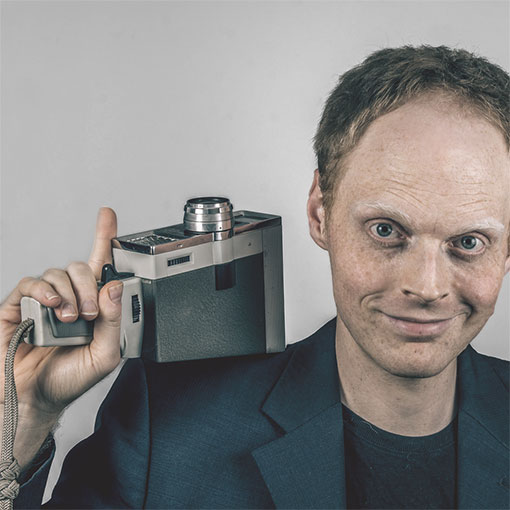
Veganism has lately grown to become a trend for those who like to think of themselves as something better. And this is what the unhealthy looking Congener is up to. Because obviously, nothing is cooler than to read ingredients lists and to be able to listen to weird jokes about your own way of life. As an ultimate hipster, the Congener has made up his mind to maximize his intolerance and is constantly in search of new possibilities to to get on people's nerves. So, how to maximize exaggeration? (Vegetarians are actually quite okay.) Hence, in his embarrassing video blog, he is now for instance telling people why killing animals is dumb. (Yes, lions do it all the time, but they are bad discussion partners.) He is drawing non-funny comics and writes ridiculous blog texts. And for some reason, he is sometimes writing about himself as a third party. Supposedly, not to appear as arrogant. So, this has worked out well again.
www.der-artgenosse.de
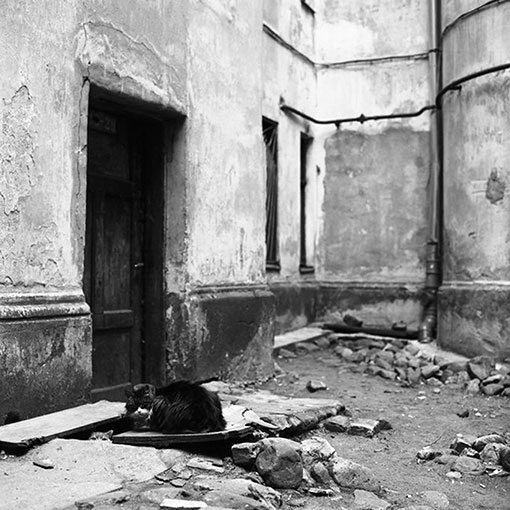
"How the other half lives" is a photobook on subjects like liberty, isolation, discrimination, anarchy, loneliness and other apsects of the daily life of stray cats. In interviews, the various strays share their wisdom gained on the streets and elucidate their view of contemporary society.
www.nicobaumgarten.net
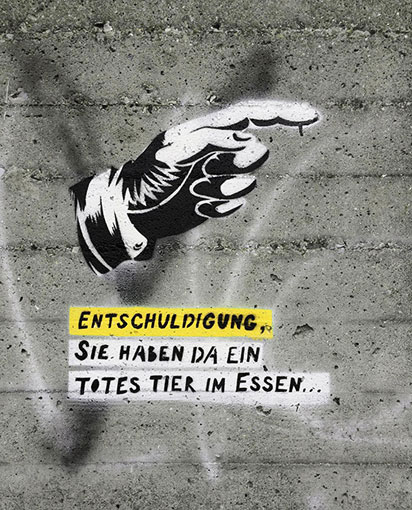
Fjodorrr is a vegan-activist street art collective. Drawings and interventions in public space are created.
www.facebook.com/fjodorrr
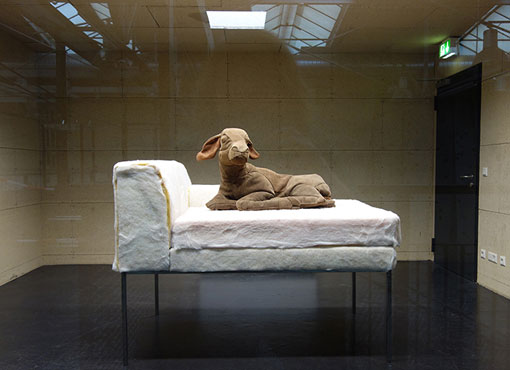
The artists Hörner/Antlfinger, who have been collaborating since the 1990's, in dialogue with human and non-human characters in the "arts system" and the "everything-else system", are investigating politically controversial subjects and developing critical perspectives on the present. The political and the utopia of the equitable interaction between human, animal and machine is a recurring theme in their work.
www.h--a.org
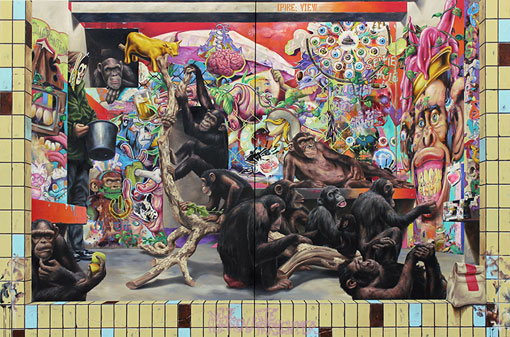
Central and overarching theme is the human being which has been manipulated and drawn into a destructive dependency by the world of communication. More generally, the work addresses humanities, sociology and urbanity. Engineering and communication rule our lives, we are globally connected, infiltrated and monitored, without being able to comprehend this entanglement. It is a system of distorted mirrors which generates obsessions and superfiscialities. Each and every day, we are exposed to the constant flood of sound and images of our information society. We are confronted with all the excesses of a completely degenerated society, in which the human being, intoxicated and blind through his/her laziness, has become the prey of his/her own progress and consumption. Idle and oversaturated we are moving through our modern cockaigne - merely capable of acting. Can we resist all these seductions and our libido? Are there ways out of here or are we simply not strong enough to turn? I consider this topic as highly relevant as it investigates both an important and contemporary field of our society and cultural identities to figure out if they are still differentiable. Basically, I consider any engagement with socio-cultural themes as an advancement of intellect and practice.
www.robert-matthes.de
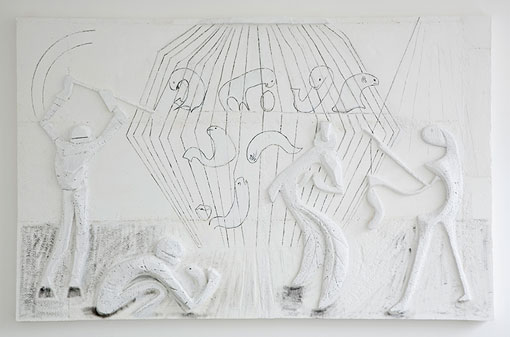
Lin May Saeed, born 1973, is both an advocate for animals and an artist. Despite progressive perspectives, empathy for animals is rarely found in visual art. We depend on animals as a society, and yet, we mostly ignore them, and often deliberately, as comrades. Saeed is approaching this theme with a compelling and convincing lightness, maybe to keep us from turning away from the uneasiness it can provoke. (Aoife Rosenmeyer)
www.linmay.de
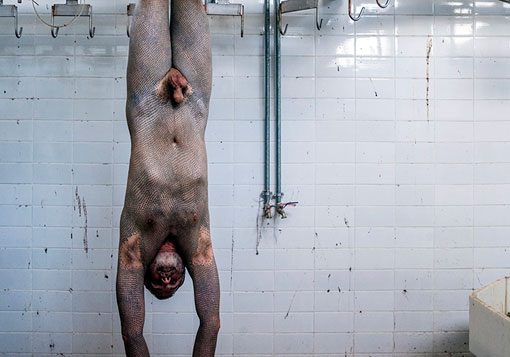
"Directly after I adopted a vegan diet, I decided that I would from now on also commit myself to animal protection. Each and every day of my life. I wanted to start off with the performances I envisioned as soon as possible. Every second counts. The 40,000 crosses [vegan tattoos] represent the number of animals being killed every second to satisfy our appetite. This is not a symbolic number, but reality."
Alfredo Meschi is quite straightforward. The Italian, born 1968 in Livorno, has worked with laser printers in the field of IT with prominent brands such as IBM and Siemens about thirty years ago. But that was also the last job of that type. Alfredo Meschio wanted to give his work a social significance. Today he is a theatre pedagogue, artist, activist and author of books on subjects of anti-speciesism which rely on the assumption that mankind doesn't have any rights other than animals do.
At the core of his activities is his engagement as a vegan activist who fights animal torture with full commitment. His conviction is literally going under his skin: Alfredo Meschi has 40,000 crosses tattooed all over his body. His love for animals and nature is an act of rebellion, which made him a vegetarian before he finally became a vegan some years ago. His father was a hunter and took him on his hunting trips to Africa as a child. Meschi rejects any sort of violence against animals and supports the theory of anti-speciesism. For many years he ran a vegetarian resaturant before shifting his battle into the artistic realm. (Article: Turi Messineo)
www.alfredomeschi.com
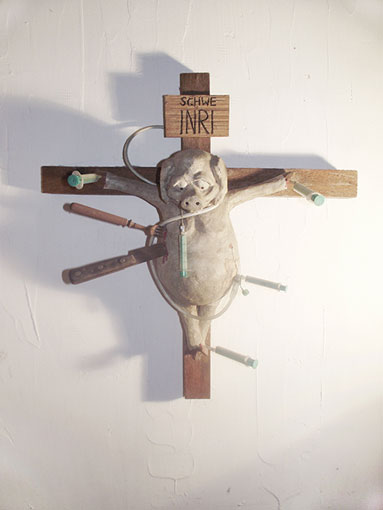
Chris Moser, born 1976, works as author and political activist in Tirol, Austria where he lives with his wife and their three children. Besides exhibiting in Austria and neighbouring countries since 1994, three months of pretrial detention in 2008, and a 14-month trial based on the suspicion that he might be a leading member of the Austrian ALF ("...one of the main actors of the militant animals rights scene", quotation police report), he is giving lectures for instance at the University of Innsbruck and in schools. Moser knows how to startle and provoke with his art. In 2008 and 2009 Moser and other activists were accused of violating § 188, vilification of religious theory, and § 124, vilification of the state and its symbols, with an art movie. His first book "Die Kunst Widerstand zu leisten" (The art of resistance) was published in 2012. Further publications are: "m.E (meines Erachtens)" 2013, the illustrated book of poems "Galerie des Entsetzens" (gallery of horror) in ccoperation with the poet T. Hainer 2014, and „viva la rebellion – ein Aufruf zum Widerstand!“ (a proclamation of resistance) 2016.
www.radikalkunst.net
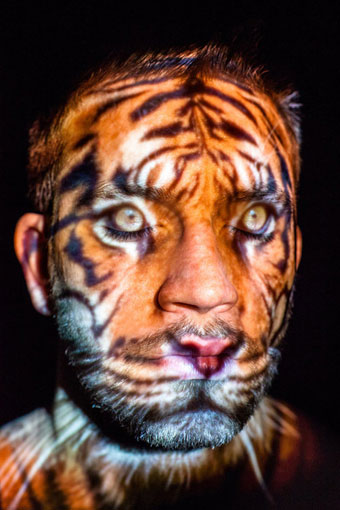
The series "Das Tier im Wir" (the animal in us) is an ongoing project about the kinship of humans and animals. Animal portraits and views are projected onto human bodies. The bodies absorb the images – flip-flop pictures and beguiling are created.
www.muellers-kabinett.de

With her work, Sarah Palmer is artistically adressing and critically questioningwith the thoughtless conumption of animal products in our society. To the question "Can art liberate animals?" she replies: I believe that art has the potential to liberate animals, because "art is the particular attention towards seeing" (John Cage) As such, art enables us to view (individual) truths attentively and from new perspectives, to depict and to question them.
spalmer.jimdo.com
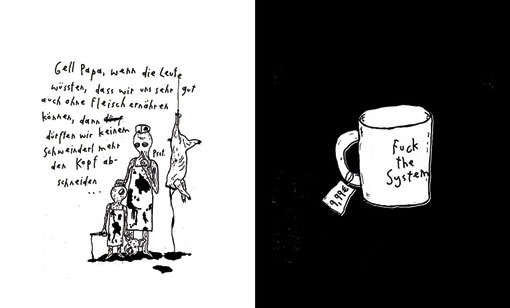
In his drawings and collages, RAS is analyzing the latest political and social activities. Not without humour, he points at any form of supression and exploitation.
www.facebook.com/xRASx
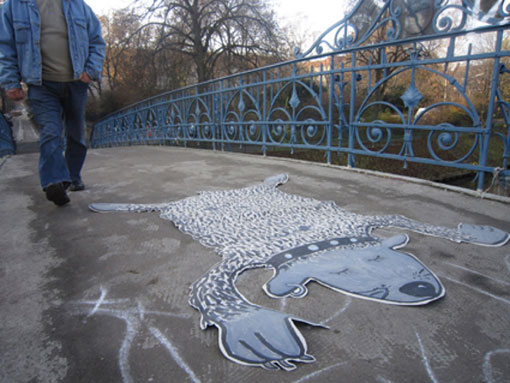
Living in Berlin, the artist Thekla Rickert was brought up in rural northern Germany. Across generations, the male members of her family passionately treasure the culture of traditional hunting as a matter of course. In her artistic work, Rickert picks up on social matters, analyzes them critically and, by means of various media, transforms them into ironic, humouristic imagery.
www.theklarickert.de

My work practices and drawing techniques display a wide variety, and I develop an individual approach for each project. This stylistic freedom allows me to experiment, to discover new realms and to travel to new places through varying topics and materials. I am particularly fascinated by the local flora and fauna and by a commitment to the detail. In the context of my Master studies, I am currently engaged in visual transfer of knowledge by infographics. Based on my activist work in the animal rights movement, many of my independent artistic subjects address our relationship with and attitude towards animals.
www.katharina-rot.de
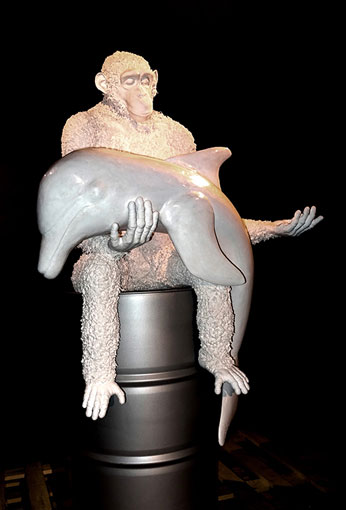
Krystyna and Manuel Valverde's works address the relationship between the human being on the one hand and nature and the world of animals on the other. The sculpture of a chimpanzee mother, sitting on an oil barrel and holding her dead dolphin child on her lap relates to the tradition of religious imagery, of which Michelangelo's Pietá is the most famous example. Despite growing up in a strictly religious milieu, Krystyna (from Poland) and Manuel (from Spain/Portugal) have long liberated themselves from religion, aided by their artistic practice, which is why they can employ the Pietá theme without a false piety. In their countries of origin, the sculpture would be read as blasphemic and likely get them into trouble if they exhibited it there.
www.krystynamanuelvalverde.com